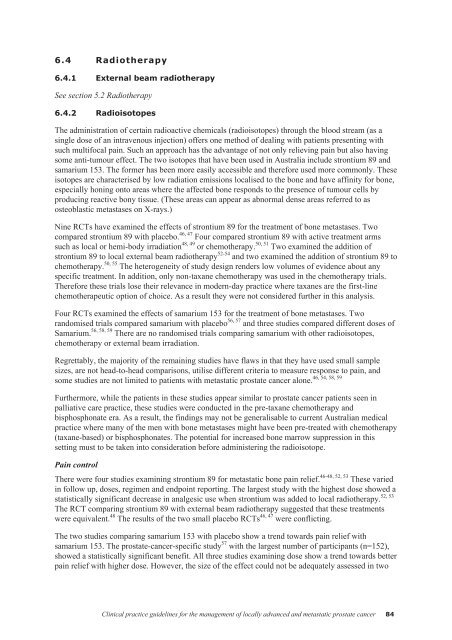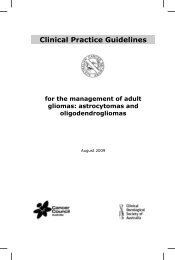Clinical Practice Guidelines for the management of locally advanced ...
Clinical Practice Guidelines for the management of locally advanced ...
Clinical Practice Guidelines for the management of locally advanced ...
Create successful ePaper yourself
Turn your PDF publications into a flip-book with our unique Google optimized e-Paper software.
6.4 Radio<strong>the</strong>rapy<br />
6.4.1 External beam radio<strong>the</strong>rapy<br />
See section 5.2 Radio<strong>the</strong>rapy<br />
6.4.2 Radioisotopes<br />
The administration <strong>of</strong> certain radioactive chemicals (radioisotopes) through <strong>the</strong> blood stream (as a<br />
single dose <strong>of</strong> an intravenous injection) <strong>of</strong>fers one method <strong>of</strong> dealing with patients presenting with<br />
such multifocal pain. Such an approach has <strong>the</strong> advantage <strong>of</strong> not only relieving pain but also having<br />
some anti-tumour effect. The two isotopes that have been used in Australia include strontium 89 and<br />
samarium 153. The <strong>for</strong>mer has been more easily accessible and <strong>the</strong>re<strong>for</strong>e used more commonly. These<br />
isotopes are characterised by low radiation emissions localised to <strong>the</strong> bone and have affinity <strong>for</strong> bone,<br />
especially honing onto areas where <strong>the</strong> affected bone responds to <strong>the</strong> presence <strong>of</strong> tumour cells by<br />
producing reactive bony tissue. (These areas can appear as abnormal dense areas referred to as<br />
osteoblastic metastases on X-rays.)<br />
Nine RCTs have examined <strong>the</strong> effects <strong>of</strong> strontium 89 <strong>for</strong> <strong>the</strong> treatment <strong>of</strong> bone metastases. Two<br />
compared strontium 89 with placebo. 46, 47 Four compared strontium 89 with active treatment arms<br />
such as local or hemi-body irradiation 48, 49 or chemo<strong>the</strong>rapy. 50, 51 Two examined <strong>the</strong> addition <strong>of</strong><br />
strontium 89 to local external beam radio<strong>the</strong>rapy 52-54 and two examined <strong>the</strong> addition <strong>of</strong> strontium 89 to<br />
chemo<strong>the</strong>rapy. 50, 55 The heterogeneity <strong>of</strong> study design renders low volumes <strong>of</strong> evidence about any<br />
specific treatment. In addition, only non-taxane chemo<strong>the</strong>rapy was used in <strong>the</strong> chemo<strong>the</strong>rapy trials.<br />
There<strong>for</strong>e <strong>the</strong>se trials lose <strong>the</strong>ir relevance in modern-day practice where taxanes are <strong>the</strong> first-line<br />
chemo<strong>the</strong>rapeutic option <strong>of</strong> choice. As a result <strong>the</strong>y were not considered fur<strong>the</strong>r in this analysis.<br />
Four RCTs examined <strong>the</strong> effects <strong>of</strong> samarium 153 <strong>for</strong> <strong>the</strong> treatment <strong>of</strong> bone metastases. Two<br />
randomised trials compared samarium with placebo 56, 57 and three studies compared different doses <strong>of</strong><br />
Samarium. 56, 58, 59 There are no randomised trials comparing samarium with o<strong>the</strong>r radioisotopes,<br />
chemo<strong>the</strong>rapy or external beam irradiation.<br />
Regrettably, <strong>the</strong> majority <strong>of</strong> <strong>the</strong> remaining studies have flaws in that <strong>the</strong>y have used small sample<br />
sizes, are not head-to-head comparisons, utilise different criteria to measure response to pain, and<br />
46, 54, 58, 59<br />
some studies are not limited to patients with metastatic prostate cancer alone.<br />
Fur<strong>the</strong>rmore, while <strong>the</strong> patients in <strong>the</strong>se studies appear similar to prostate cancer patients seen in<br />
palliative care practice, <strong>the</strong>se studies were conducted in <strong>the</strong> pre-taxane chemo<strong>the</strong>rapy and<br />
bisphosphonate era. As a result, <strong>the</strong> findings may not be generalisable to current Australian medical<br />
practice where many <strong>of</strong> <strong>the</strong> men with bone metastases might have been pre-treated with chemo<strong>the</strong>rapy<br />
(taxane-based) or bisphosphonates. The potential <strong>for</strong> increased bone marrow suppression in this<br />
setting must to be taken into consideration be<strong>for</strong>e administering <strong>the</strong> radioisotope.<br />
Pain control<br />
There were four studies examining strontium 89 <strong>for</strong> metastatic bone pain relief. 46-48, 52, 53 These varied<br />
in follow up, doses, regimen and endpoint reporting. The largest study with <strong>the</strong> highest dose showed a<br />
52, 53<br />
statistically significant decrease in analgesic use when strontium was added to local radio<strong>the</strong>rapy.<br />
The RCT comparing strontium 89 with external beam radio<strong>the</strong>rapy suggested that <strong>the</strong>se treatments<br />
were equivalent. 48 The results <strong>of</strong> <strong>the</strong> two small placebo RCTs 46, 47 were conflicting.<br />
The two studies comparing samarium 153 with placebo show a trend towards pain relief with<br />
samarium 153. The prostate-cancer-specific study 57 with <strong>the</strong> largest number <strong>of</strong> participants (n=152),<br />
showed a statistically significant benefit. All three studies examining dose show a trend towards better<br />
pain relief with higher dose. However, <strong>the</strong> size <strong>of</strong> <strong>the</strong> effect could not be adequately assessed in two<br />
<strong>Clinical</strong> practice guidelines <strong>for</strong> <strong>the</strong> <strong>management</strong> <strong>of</strong> <strong>locally</strong> <strong>advanced</strong> and metastatic prostate cancer<br />
84



